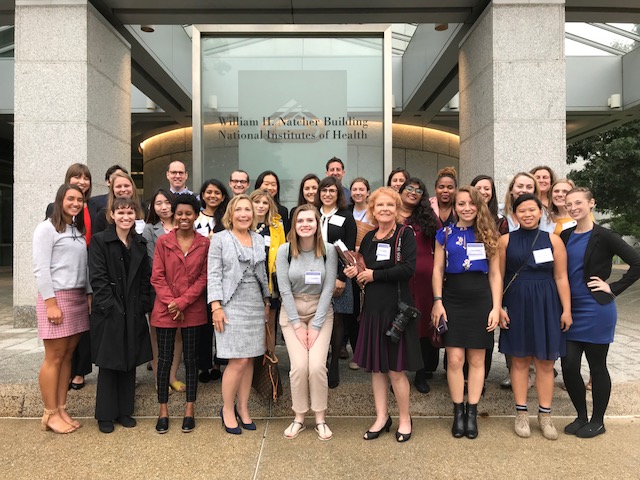By Alexis Shanes and Colleen Zewe
WASHINGTON – As America’s opioid crisis intensifies, necessitating treatment for more than 20 million people, stakeholders clash on potential solutions.
A panel discussion about the epidemic — and how reporters should approach it — provided one of many highlights of Medill’s fourth annual Health Care Reporting Conference, held Sept. 24-26 in Washington D.C.
The conference brought 30 undergraduate and graduate journalism students to Washington for panel discussions in the D.C. newsroom, visits with leaders at the National Institutes of Health and Defense Health Headquarters, and dinner with prominent D.C. health reporters, several of them Medill alums.
“This conference gives students an insider’s perspective and helps them hit the ground running in their future careers,” said Abigail Foerstner, Medill assistant professor.
Foerstner, along with Medill professors Donna Leff and Ellen Shearer, executive editor of Medill Washington, organized the conference, which was funded by UnitedHealth Group.
The conference was longer than in previous years, spanning two and a half days instead of one and three-quarters, “which allowed us to provide even more information on pressing health issues,” Shearer said.
“We added a panel on the health care implications of climate change and a talk by editor Laura Helmuth, a Ph.D. in neuroscience, about the innovative and engaging Health and Science section of The Washington Post,” she added. Panelists representing major players in health controversies covered the rising costs of pharmaceuticals, the uncertain future of health care policy, the health threats of climate change, epidemics, and bridging the gap between science and politics for general audiences.
Insiders included consultant and former assistant vice president of the National Council for Behavioral Health Nick Szubiak, USA Today health reporter Jayne O’Donnell, and actress and advocate Lise Hilboldt, who all agreed that opioid addiction is a treatable disease, contrary to societal stigmas.
“You are losing control,” Szubiak said, explaining how the brain becomes drug-dependent. “You’re on a runaway train, and you know you should stop, but you can’t,” without help.
Treatment options range from therapeutic drugs that replace opioids to long-term rehabilitation programs. No one-size-fits-all solution exists, the panelists said.
“Nothing is simple in addiction,” Hilboldt said. “Anyone is sober a day at a time. People have to completely want to stop.”
Research is key to fighting and ending epidemics and illness of all kinds. To understand the scale and complexity of medical studies, conference attendees toured the 244-bed National Institutes of Health research hospital in Bethesda, Maryland.
The NIH spans 27 areas of medicine and its 7,000 doctors and researchers have a “bench to bedside” mentality, NIH information specialist Carol Jabir said.
The hospital also pays for participants’ domestic travel to the hospital, Jabir said, and offers financial assistance programs to help inpatients keep up with their bills at home.
“We want you to get well,” said Susan Robinson, a NIH tour guide. “We don’t want you worrying about what’s going on at home.”
On the other side of the Potomac River, students visited the Defense Health Headquarters in Falls Church, Virginia. Brigadier General Jill Faris, who oversees Army Medicine, briefed them on innovations in burn care, tourniquets, virtual diagnostic capabilities and vaccines.
“If we can do things well in the Army, we can help civilians do as we do,” she said, adding that military health care research is responsible for countless staple civilian health care programs.
Helicopter ambulances, which the Army first used during the Korean and Vietnam Wars, now are common in civilian hospital systems.
The panel of environmental policy experts explored how climate change and hotter conditions amplify health conditions, such as allergies, asthma, Lyme disease, heat stroke and trauma-induced stress.
“People don’t like to think they’re vulnerable. They like to think the vulnerable people are the other people over there,” said panelist Allison Crimmins, a U.S. Environmental Protection

